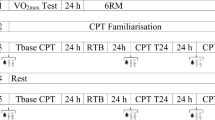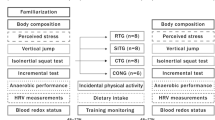Abstract
Purpose
To describe the acute and delayed time course of recovery following resistance training (RT) protocols differing in the number of repetitions (R) performed in each set (S) out of the maximum possible number (P).
Methods
Ten resistance-trained men undertook three RT protocols [S × R(P)]: (1) 3 × 5(10), (2) 6 × 5(10), and (3) 3 × 10(10) in the bench press (BP) and full squat (SQ) exercises. Selected mechanical and biochemical variables were assessed at seven time points (from − 12 h to + 72 h post-exercise). Countermovement jump height (CMJ) and movement velocity against the load that elicited a 1 m s−1 mean propulsive velocity (V1) and 75% 1RM in the BP and SQ were used as mechanical indicators of neuromuscular performance.
Results
Training to muscle failure in each set [3 × 10(10)], even when compared to completing the same total exercise volume [6 × 5(10)], resulted in a significantly higher acute decline of CMJ and velocity against the V1 and 75% 1RM loads in both BP and SQ. In contrast, recovery from the 3 × 5(10) and 6 × 5(10) protocols was significantly faster between 24 and 48 h post-exercise compared to 3 × 10(10). Markers of acute (ammonia, growth hormone) and delayed (creatine kinase) fatigue showed a markedly different course of recovery between protocols, suggesting that training to failure slows down recovery up to 24–48 h post-exercise.
Conclusions
RT leading to failure considerably increases the time needed for the recovery of neuromuscular function and metabolic and hormonal homeostasis. Avoiding failure would allow athletes to be in a better neuromuscular condition to undertake a new training session or competition in a shorter period of time.




Similar content being viewed by others
Abbreviations
- ANOVA:
-
Analysis of variance
- Basal AM:
-
The same morning of the resistance training protocol at 8:00 h
- Basal PM:
-
The day before the resistance training protocol at 18:00 h
- BP:
-
Bench press
- CK:
-
Creatine kinase
- CMJ:
-
Countermovement jump
- ES:
-
Effect size
- GH:
-
Growth hormone
- MPV:
-
Mean propulsive velocity
- Post 0 h:
-
Immediately following each resistance training protocol (11:00 h)
- Post 6 h:
-
Same evening of resistance training, at 18:00 h
- Post 24 h:
-
24 h after the resistance training protocol
- Post 48 h:
-
48 h after the resistance training protocol
- Post 72 h:
-
72 h after the resistance training protocol
- RT:
-
Resistance training
- SQ:
-
Full back squat
- SD:
-
Standard deviation
- T/C:
-
Testosterone/cortisol ratio
- V1 load:
-
The load that elicited a ~ 1.00 m s−1 mean propulsive velocity
References
Bartolomei S, Sadres E, Church DD, Arroyo E, Iii JAG, Varanoske AN, Wang R, Beyer KS, Oliveira LP, Stout JR, Hoffman JR (2017) Comparison of the recovery response from high-intensity and high-volume resistance exercise in trained men. Eur J Appl Physiol 117(7):1287–1298
Cohen J (1988) Statistical power analysis for the behavioral sciences, 2nd edn. Lawrence Erlbaum Associates, New Jersey, p 569
Crewther B, Keogh J, Cronin J, Cook C (2006) Possible stimuli for strength and power adaptation: acute hormonal responses. Sports Med 36(1):215–238
Davies T, Orr R, Halaki M, Hackett D (2016) Effect of training leading to repetition failure on muscular strength: a systematic review and meta-analysis. Sports Med 46(4):487–502
Folland JP, Irish CS, Roberts JC, Tarr JE, Jones DA (2002) Fatigue is not a necessary stimulus for strength gains during resistance training. Br J Sports Med 36(5):370–373
García-Pallarés J, Sánchez-Medina L, Carrasco L, Díaz A, Izquierdo M (2009) Endurance and neuromuscular changes in world-class level kayakers during a periodized training cycle. Eur J Appl Physiol 106(4):629–638
García-Pallarés J, Sánchez-Medina L, Pérez CE, Izquierdo-Gabarren M, Izquierdo M (2010) Physiological effects of tapering and detraining in world-class kayakers. Med Sci Sports Exerc 42(6):1209–1214
González-Badillo JJ, Rodríguez-Rosell D, Sánchez-Medina L, Ribas J, López-López C, Mora-Custodio R, Yáñez-García JM, Pareja-Blanco F (2016) Short-term recovery following resistance exercise leading or not to failure. Int J Sports Med 37(4):295–304
Gordon SE, Kraemer WJ, Vos NH, Lynch JM, Knuttgen HG (1994) Effect of acid-base balance on the growth hormone response to acute high-intensity cycle exercise. J Appl Physiol 76(3):821–829
Gorostiaga EM, Asiáin X, Izquierdo M, Postigo A, Aguado R, Alonso JM, Ibáñez J (2010) Vertical jump performance and blood ammonia and lactate levels during typical training sessions in elite 400-m runners. J Strength Cond Res 24(4):1138–1149
Gorostiaga EM, Navarro-Amézqueta I, Calbet JA, Hellsten Y, Cusso R, Guerrero M, Granados C, González-Izal M, Ibáñez J, Izquierdo M (2012) Energy metabolism during repeated sets of leg press exercise leading to failure or not. PLoS One 7(7):e40621
Gorostiaga EM, Navarro-Amézqueta I, Calbet JA, Sánchez-Medina L, Cusso R, Guerrero M, Granados C, González-Izal M, Ibáñez J, Izquierdo M (2014) Blood ammonia and lactate as markers of muscle metabolites during leg press exercise. J Strength Cond Res 28(10):2775–2785
Izquierdo M, Häkkinen K, González-Badillo JJ, Ibáñez J, Gorostiaga EM (2002) Effects of long-term training specificity on maximal strength and power of the upper and lower extremities in athletes from different sports. Eur J Appl Physiol 87(3):264–271
Izquierdo M, Ibáñez J, González-Badillo JJ, Häkkinen K, Ratamess NA, Kraemer WJ, French DN, Eslava J, Altadill A, Asiain X, Gorostiaga EM (2006) Differential effects of strength training leading to failure versus not to failure on hormonal responses, strength, and muscle power gains. J Appl Physiol 100(5):1647–1656
Izquierdo-Gabarren M, González de Txabarri Expósito R, García-Pallarés J, Sánchez-Medina L, De Villarreal ES, Izquierdo M (2010) Concurrent endurance and strength training not to failure optimizes performance gains. Med Sci Sports Exerc 42(6):1191–1199
Kraemer WJ, Ratamess NA (2005) Hormonal responses and adaptations to resistance exercise and training. Sports Med 35(4):339–361
Kraemer WJ, Ratamess NA (2006) Fundamentals of resistance training: progression and exercise prescription. Med Sci Sports Exerc 36(4):674–688
Mora-Rodríguez R, García Pallarés J, López-Samanes A, Ortega JF, Fernández-Elías VE (2012) Caffeine ingestion reverses the circadian rhythm effects on neuromuscular performance in highly resistance-trained men. PLoS One 7(4):e33807
Mora-Rodríguez R, Pallarés JG, López-Gullón JM, López-Samanes Á, Fernández-Elías VE, Ortega JF (2015) Improvements on neuromuscular performance with caffeine ingestion depend on the time-of-day. J Sci Med Sport 18(3):338–342
Morton RW, Oikawa SY, Wavell CG, Mazara N, McGlory C, Quadrilatero J, Baechler BL, Baker SK, Phillips SM (2016) Neither load nor systemic hormones determine resistance training-mediated hypertrophy or strength gains in resistance-trained young men. J Appl Physiol 121(1):129–138
Pallarés JG, Fernández-Elías VE, Ortega JF, Muñoz G, Muñoz-Guerra J, Mora-Rodríguez R (2013) Neuromuscular responses to incremental caffeine doses: performance and side effects. Med Sci Sports Exerc 45(11):2184–2192
Pallarés JG, Sánchez-Medina L, Pérez CE, de La Cruz-Sánchez E, Mora-Rodriguez R (2014) Imposing a pause between the eccentric and concentric phases increases the reliability of isoinertial strength assessments. J Sports Sci 32(12):1165–1175
Pallarés JG, López-Samanes A, Fernández-Elías VE, Aguado-Jiménez R, Ortega JF, Gómez C, Ventura R, Segura J, Mora-Rodríguez R (2015) Pseudoephedrine and circadian rhythm interaction on neuromuscular performance. Scand J Med Sci Sports 25(6):e603-12
Pareja-Blanco F, Rodríguez-Rosell D, Sánchez-Medina L, Ribas-Serna J, López-López C, Mora-Custodio R, Yáñez-García JM, González-Badillo J (2016) Acute and delayed response to resistance exercise leading or not leading to muscle failure. Clin Physiol Funct Imaging. doi:10.1111/cpf.12348
Pareja-Blanco F, Rodríguez-Rosell D, Sánchez-Medina L, Sanchís-Moysi J, Dorado C, Mora-Custodio R, Yáñez-García JM, Morales-Álamo D, Pérez-Suárez I, Calbet JAL, González-Badillo JJ (2017) Effects of velocity loss during resistance training on athletic performance, strength gains and muscle adaptations. Scand J Med Sci 27(7):724–735
Ratamess NA, Alvar BA, Evetoch TK, Housh TJ, Kibler WB, Kraemer WJ (2009) Progression models in resistance training for healthy adults [ACSM position stand]. Med Sci Sports Exerc 41(3):687–708
Sampson JA, Groeller H (2016) Is repetition failure critical for the development of muscle hypertrophy and strength? Scand J Med Sci Sport 26(4):375–383
Sanborn K, Boros K, Hruby J, Schilling B, O’bryant HS, Johnson RL, Hoke T, Stone ME, Stone MH (2000) Short-term performance effects of weight training with multiple sets not to failure vs a single set to failure in women. J Strength Cond Res 14(3):328–331
Sánchez-Medina L, González-Badillo JJ (2011) Velocity loss as an indicator of neuromuscular fatigue during resistance training. Med Sci Sports Exerc 43(9):1725–1734
Sánchez-Medina L, Pérez CE, González-Badillo JJ (2010) Importance of the propulsive phase in strength assessment. Int J Sports Med 31(2):123–129
Sánchez-Medina L, González-Badillo JJ, Pérez CE, Pallarés JG (2013) Velocity- and power-load relationships of the bench pull versus bench press exercises. Int J Sports Med 35(03):209–216
Sánchez-Medina L, Pallarés JG, Pérez CE, Morán-Navarro R, González Badillo JJ (2017) Estimation of relative load from bar velocity in the full back squat exercise. Sports Med Int Open 1(2):E80–E88
Spiering BA, Kraemer WJ, Anderson JM, Armstrong LE, Nindl BC, Volek JS, Maresh CM (2008) Resistance exercise biology: manipulation of resistance exercise programme variables determines the responses of cellular and molecular signalling pathways. Sports Med 38(7):527–540
West DW, Phillips SM (2010) Anabolic processes in human skeletal muscle: restoring the identities of growth hormone and testosterone. Phys Sports Med 38(3):97–104
Author information
Authors and Affiliations
Corresponding author
Additional information
Communicated by William J. Kraemer.
Rights and permissions
About this article
Cite this article
Morán-Navarro, R., Pérez, C.E., Mora-Rodríguez, R. et al. Time course of recovery following resistance training leading or not to failure. Eur J Appl Physiol 117, 2387–2399 (2017). https://doi.org/10.1007/s00421-017-3725-7
Received:
Accepted:
Published:
Issue Date:
DOI: https://doi.org/10.1007/s00421-017-3725-7




